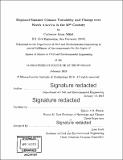| dc.contributor.advisor | Elfatih A.B. Eltahir. | en_US |
| dc.contributor.author | Nikiel, Catherine Anna | en_US |
| dc.contributor.other | Massachusetts Institute of Technology. Department of Civil and Environmental Engineering. | en_US |
| dc.date.accessioned | 2018-05-23T16:35:25Z | |
| dc.date.available | 2018-05-23T16:35:25Z | |
| dc.date.copyright | 2018 | en_US |
| dc.date.issued | 2018 | en_US |
| dc.identifier.uri | http://hdl.handle.net/1721.1/115800 | |
| dc.description | Thesis: S.M., Massachusetts Institute of Technology, Department of Civil and Environmental Engineering, 2018. | en_US |
| dc.description | Cataloged from PDF version of thesis. | en_US |
| dc.description | Includes bibliographical references (pages 119-131). | en_US |
| dc.description.abstract | The climate of North America reflects the natural variability of global atmospheric circulation, and is impacted by two primary anthropogenic forcings: increasing concentrations of greenhouse gases (GHG) and Land Use/Land Cover Change (LULC). The objective of this thesis is to quantify the relative impacts that these two anthropogenic forcings have had on summer climate over North America in the course of the 20th century. Simulations are conducted spanning the full 20th century over the United States to the east of the Rocky Mountains, and analysis of model simulations and observations is carried out with a focus on the Midwestern United States. This region has exhibited significant changes in climate from the early to late 20th century, and has been impacted not only by increasing GHG concentrations but by rapid and extensive agricultural LULC changes. These land use changes can be broken into three components: expansion of agriculture, expansion of irrigated cropland, and agricultural intensification in the form of linear productivity gains for corn and soybean. The simulations in this thesis use a modified version of the MIT Regional Climate Model (MRCM). New input data sets are used in order to represent contemporaneous and evolving lateral and surface boundary conditions. Studies in the past have shown a link between LULC changes and regional/local climate change, and in particular cropland-influenced climatic change in regions with high agricultural intensity. This thesis adopts an approach involving the application of long-term simulations of historic LULC evolution in conjunction with appropriate scenarios of GHG concentrations. Two sets of simulations are run using either ERA20C or CERA20C 20th century reanalysis data from the European Centre for Medium-Range Weather Forecasting. The simulations are conducted from 1900 or 1901 to 2005 based on data availability, at 30 km resolution on 18 vertical pressure levels. Analysis of changes from 1920-1949 to 1970-1999 show that in most cases, the regional climate impacts from vegetation development in the study area over this period outweigh the impacts from greenhouse gases, but in all variables except temperature, the combined impacts of LULC and GHG alone are not adequate to reproduce the observed climate changes. The analysis of background conditions points to the potentially strong impact of internal variability, and the strong influence that the assumed boundary conditions based on reanalysis data can impose on model results. | en_US |
| dc.description.statementofresponsibility | by Catherine Anna Nikiel. | en_US |
| dc.format.extent | 169 pages | en_US |
| dc.language.iso | eng | en_US |
| dc.publisher | Massachusetts Institute of Technology | en_US |
| dc.rights | MIT theses are protected by copyright. They may be viewed, downloaded, or printed from this source but further reproduction or distribution in any format is prohibited without written permission. | en_US |
| dc.rights.uri | http://dspace.mit.edu/handle/1721.1/7582 | en_US |
| dc.subject | Civil and Environmental Engineering. | en_US |
| dc.title | Regional summer climate variability and change over North America in the 20th Century | en_US |
| dc.type | Thesis | en_US |
| dc.description.degree | S.M. | en_US |
| dc.contributor.department | Massachusetts Institute of Technology. Department of Civil and Environmental Engineering | |
| dc.identifier.oclc | 1036988214 | en_US |

